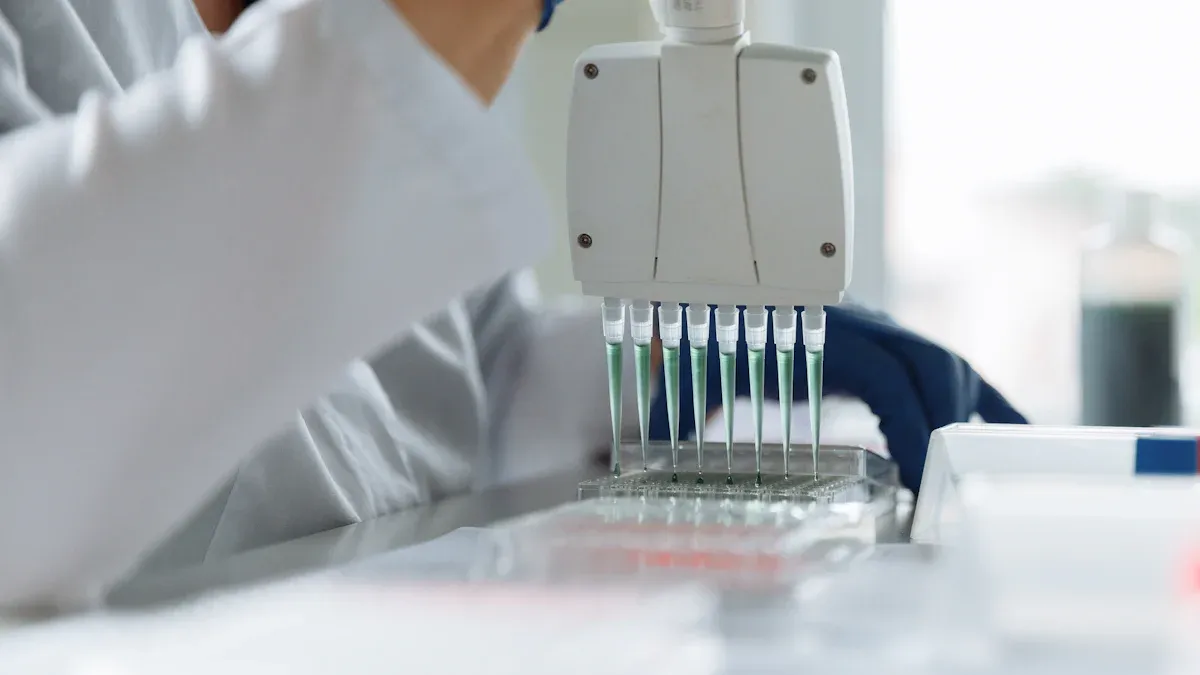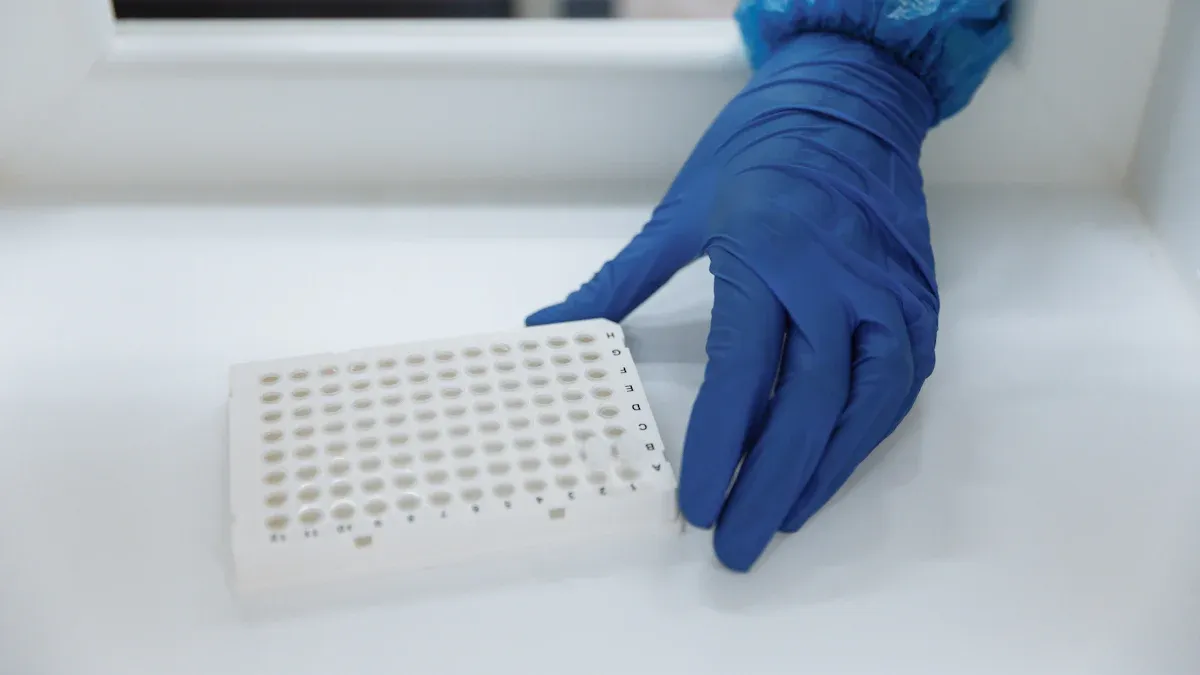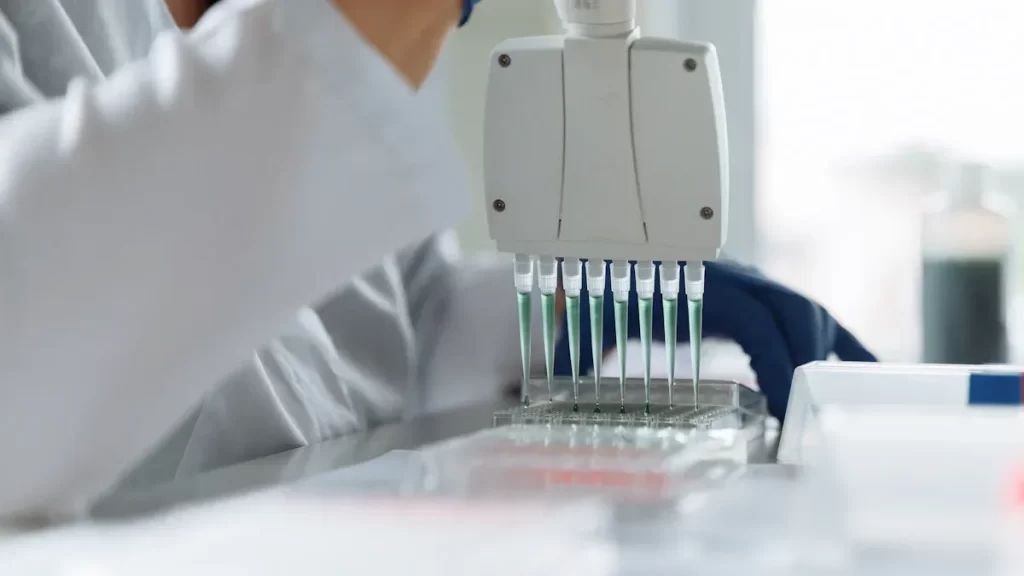News & Events
5 Tips for Using 96 Well Plate Templates in Western Blotting

You often face the challenge of processing dozens of samples while trying to keep every step organized. A 96 well plate template helps you run your experiment faster by allowing you to handle many samples at once. This template works with standard lab tools, so you do not need special equipment. You improve reproducibility, save time, and keep your workflow smooth when you use a 96-well system.
Key Takeaways
- Choose the right 96 well plate template to match your experiment goals. This choice boosts efficiency and improves reproducibility.
- Organize your samples and controls carefully. A clear labeling system and strategic sample placement reduce errors and enhance reliability.
- Prevent cross-contamination by using proper pipetting techniques. Change tips after each transfer and seal plates during incubation.
- Optimize reagent usage by calculating the exact volumes needed for each well. This step saves materials and improves experiment efficiency.
- Document and track results effectively. Use templates for data management and integrate digital tools to streamline your workflow.
Choose the Right 96 Well Plate Template

Match Template to Experiment Needs
You need to select a 96 well plate template that fits your experiment goals. The right template helps you run a high-throughput assay and process many protein samples at once. This choice boosts efficiency and lets you screen multiple compounds in a single experiment. When you use a 96-well format, you can test more protein samples and get results faster. You also improve reproducibility because you minimize sample manipulation and reduce errors.
Tip: Always match your template to the type of assay and protein you want to analyze. If you plan a high-throughput experiment, a 96 well plate template works best. For basic protein experiments, a 6-well or 24-well plate may suit your needs better.
Here is a quick comparison to help you choose:
| Well Plate Type | Suitable For | Notes |
|---|---|---|
| 96-well plate | High-throughput screening, drug testing, antibody experiments | Improves work efficiency |
| 6-well plate | Basic experiments, single cell line culture | More suitable for low-throughput experiments like Western blotting |
| 24-well plate | Low-throughput experiments | More suitable for Western blotting |
You should use a 96 well plate template when you want to run a high-throughput assay and analyze many protein samples in one experiment. This method shows high similarity to traditional Western blotting and increases efficiency by up to eight times.
Consider Compatibility with Equipment
Check if your template fits your lab equipment before starting your experiment. The 96-well format works with most standard plate readers and pipettes. You need to make sure your assay workflow supports the template you choose. Automation helps you handle protein samples with less error and keeps your experiment reproducible.
- Look for templates that match your plate reader and pipette sizes.
- Test if your protein assay reagents work well in the 96-well format.
- Use templates that allow single well analysis to reduce mistakes when transferring protein samples.
| Evidence Point | Description |
|---|---|
| Sample Manipulation | Minimizing sample manipulation reduces variability in results. |
| Intra- and Inter-plate Variability | Using a miniaturized platform decreases variability across different plates. |
| Automation | Automation of processes enhances reproducibility by standardizing sample handling. |
| Single Well Analysis | Analyzing PTMs from a single well reduces the chances of error associated with transferring samples. |
| Screening Capacity | The setup allows for screening multiple compounds efficiently while maintaining reproducibility. |
You improve your experiment results when you choose a template that matches your assay needs and equipment. This step helps you get reliable protein data and keeps your workflow smooth.
Organize Samples and Controls
Proper organization of your samples and controls sets the foundation for a successful experiment. When you use a 96 well plate template, you can process many protein samples at once. This approach helps you keep track of each assay and reduces the risk of mixing up samples. Good organization also improves reproducibility and makes your workflow more efficient.
Strategic Sample Placement
You should plan the placement of your protein samples and controls before you start the experiment. Place your controls in the same wells across different plates to make it easier to compare results. For example, you can use the first column for positive controls and the last column for negative controls. This method helps you spot errors quickly and ensures that your high-throughput assay stays reliable.
- Place replicates of each protein sample in adjacent wells.
- Separate different protein conditions by rows or columns.
- Keep a consistent pattern for every experiment.
Tip: Use a printed map of your 96-well plate to mark where each protein sample and control goes. This habit helps you avoid mistakes during the assay.
Clear Labeling for Assay Clarity
A clear labeling system is key for tracking your protein samples and controls. Use alphanumeric codes, such as A1, B2, or C3, to identify each well. Combine this with a labeling system that matches your experiment plan. This method lets you find any protein sample or control quickly during the assay.
| Recommendation | Description |
|---|---|
| Labeling System | Develop a labeling system that complements the alphanumeric coding to keep track of different samples and conditions easily. |
Write down your labeling plan in your lab notebook or use a digital tool. This step helps you track every protein sample and control throughout the experiment. You can also print a table to keep next to your 96-well plate template for quick reference.
When you organize your samples and controls with care, you reduce errors and make your high-throughput protein assay more reliable.
Prevent Cross-Contamination
Cross-contamination can ruin your experiment and make your assay results unreliable. You need to follow best practices to keep your protein samples pure and your data accurate. When you use a 96 well plate template for high-throughput Western blotting, you handle many protein samples at once. This increases the risk of contamination, so you must stay alert and use smart techniques.
Pipetting Techniques in 96-Well Format
You can lower the risk of cross-contamination by using careful pipetting methods. Always change pipette tips after each transfer. This simple step keeps protein samples separate and protects your experiment. Multi-channel pipettes or automated liquid handlers help you work faster and reduce mistakes in high-throughput assays. Seal your 96-well plate with adhesive films or lids during incubation. This barrier stops outside contaminants from reaching your protein samples.
| Recommendation | Description |
|---|---|
| Change pipette tips after each transfer | Prevents cross-contamination between protein samples. |
| Use multi-channel pipettes or automation | Improves precision and lowers contamination risk in high-throughput assays. |
| Seal plates with adhesive films or lids | Protects protein samples during incubation. |
You should randomize your protein samples across the plate to avoid systematic errors. Do not process samples with different biomasses together. Manual single-tube extractions help you keep each protein sample pure.
Use Guides to Avoid Mix-Ups
Physical guides and color coding make your workflow easier and safer. Use colored stickers or markers to separate protein conditions on your 96-well plate template. This visual aid helps you spot errors before they affect your experiment. You can also use printed maps or digital guides to track each protein sample and control. These tools improve reproducibility and keep your assay results clear.
Tip: Use a combination of blocking agents, such as amicase and BSA, to reduce non-specific binding in your assay. Mix and filter your blocking solutions well before use. Wash membranes with care to remove interfering substances before adding substrates.
You should test blocking conditions for each protein target. Non-fat dried milk works for many assays, but BSA is better for biotin or anti-phospho-protein antibodies. Use a 2.5–5% solution of blocking agents in TBST or PBS for best results.
When you follow these steps, you protect your protein samples and keep your experiment reliable. Good habits in pipetting and organization help you get clear, reproducible assay data every time.
Optimize Reagent Usage
Calculate Volumes for 96-Well Assay
You can save reagents and reduce waste when you use a 96-well plate-based method for your protein assay. The small well size means you need less sample and fewer antibodies for each experiment. You should calculate the exact volume needed for each well before you start. This step helps you avoid running out of reagents during your high-throughput experiment.
- Measure the minimum volume required for your protein assay in each well.
- Prepare only what you need for the 96-well plate-based method.
- Use a table to track reagent volumes for each protein sample and control.
| Reagent | Volume per Well | Total Volume (96-well) |
|---|---|---|
| Sample Buffer | 10 µL | 960 µL |
| Antibody | 5 µL | 480 µL |
| Substrate | 10 µL | 960 µL |
The traditional blotting method can use up to 300 pieces of plastic and Simple Western uses two. What’s even better is that Simple Western can run up to 40 proteins in three days. It would take about a week to run 40 proteins using Western blotting.
You can see that the 96-well plate-based method helps you save time and reagents. This approach also improves reproducibility because you use the same amount for every protein sample.
Streamline Workflow Steps
You can make your experiment faster and more efficient by planning your workflow. The 96-well plate-based method lets you run many protein assays at once. You should set up your experiment so you can add reagents and samples in batches. This step helps you avoid mistakes and keeps your protein samples organized.
- Prepare all reagents before you start the assay.
- Use multi-channel pipettes to add reagents to the 96-well plate.
- Label each protein sample and control clearly.
Jess allows me to reduce the preparation time, save on reagents, samples, and antibodies, while allowing easier optimization of target proteins/antibodies. Jess’s ability to detect multiple proteins per sample further saves time compared to conventional Western blot.
You can optimize your workflow by using automation and planning each step. The 96-well plate-based method supports high-throughput experiments and helps you get results faster. You also improve reproducibility because you follow the same steps for every protein assay.
Tip: Always double-check your reagent calculations before starting the experiment. This habit helps you avoid running out of supplies and keeps your workflow smooth.
Document and Track Results

Use Template for Data Management
You need a clear system to record every protein sample and control in your experiment. A 96-well plate template helps you organize your assay data and track each step. You can write down sample IDs, protein concentrations, and assay conditions directly on the template. This habit keeps your experiment organized and makes it easy to find mistakes.
Tip: Always use a printed or digital template to record your protein sample locations and assay results. This step helps you compare data across different experiments and improves reproducibility.
Many labs use electronic recordkeeping to centralize experiment documentation. Barcode technology gives each plate a unique ID, which helps you track protein samples and assay results. Digital well plate mapping lets you see the arrangement of samples and controls, making it easier to interpret your experiment data.
Best Practices for Data Management:
- Use standardized plate layouts for every experiment.
- Label plates with barcodes for easy identification.
- Map wells digitally to track protein samples and controls.
- Create custom labels for better organization.
- Store all experiment records in a central digital system.
Integrate with Digital Tools
You can improve your workflow by linking your 96-well plate template with digital tools. Many software options help you manage assay data and support high-throughput experiments. These tools let you convert plate maps, prepare input files, and analyze protein results quickly.
| Tool Name | Functionality |
|---|---|
| 96to384 | Converts 96-well plate maps for batch processing in high-throughput experiments. |
| PlateToTaqMan | Generates input files for assay analysis, making data integration easier. |
| ResultsFileBuilder | Prepares Excel files for protein genotyping results. |
| TaqMan2Results | Transfers assay results with built-in quality control. |
| Count | Performs statistical analysis on protein assay results. |
Look for digital tools with features like automated template generation, natural language interfaces, and color-coded well identifiers. These features help you organize protein samples, validate assay data, and adapt templates for different experiment needs.
| Key Features | Description |
|---|---|
| Automated Template Generation | Instantly creates customized 96-well templates with sample IDs and concentrations. |
| Data Validation Rules | Checks for accuracy in assay data entry. |
| Statistical Analysis Formulas | Calculates averages and other metrics for protein experiments. |
| Color-Coded Well Identifiers | Improves visual organization of protein samples and controls. |
Note: Integrating barcode plate labels and digital mapping reduces manual errors and keeps your assay results reliable.
You can use electronic lab notebooks to store all experiment data. This method gives you better visibility and traceability for every protein assay. When you combine templates with digital tools, you make your high-throughput experiments more reproducible and easier to manage.
You can boost your lab’s efficiency and get more reliable results by using 96 well plate templates in Western blotting. These templates help you organize samples, reduce errors, and save time. Try the five tips from this blog to make your experiments smoother.
Have you used 96 well plate templates? Share your tips or experiences in the comments below!
FAQ
What is the best way to start assay development workflow using 96 well plate templates?
You should begin with preset plate templates. These templates help you plan your experimental design and antibody selection. They also support normalization and quantification. This approach improves assay quality and makes development faster.
How do you validate antibodies for in-cell western assay?
You validate antibodies by testing selectivity and signal strength. Use experimental controls to check for background signal. Antibody validation ensures you measure true expression. Repeat the process for each antibody to confirm results. This step is key for assay quality and development.
Why is normalization important in quantification and expression analysis?
Normalization corrects for differences in sample loading and signal variation. You use a normalization method to compare expression levels. This process improves quantification accuracy. It also helps you track changes in signal during development and antibody validation.
How do you choose the right primary antibody concentration for high-throughput antibody isolation protocol?
You test different concentrations during development. Start with a range of primary antibody concentration values. Measure signal and selectivity for each. Use quantification to pick the best concentration. This step supports antibody validation and improves assay quality.
What controls should you include in experimental design for in-cell western assay?
You need positive and negative experimental controls. These controls help you check antibody selectivity and signal. Controls also support normalization and quantification. Good experimental design with proper controls improves assay quality and antibody validation.

